Yoko Hiraoka
String Instruments
of Japan
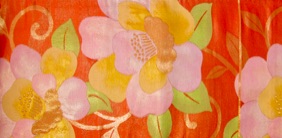

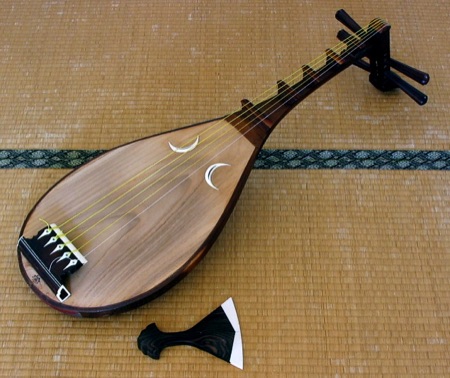
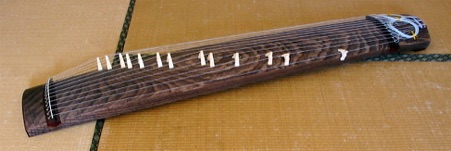
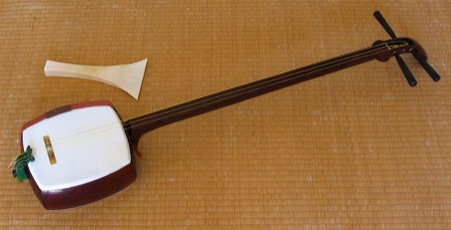
One of the more recognizable instruments of Japan, the koto consists of a 6 foot long shallow resonating box (made from Paulownia wood) with a set of thirteen strings stretched over movable ivory bridges. This arrangement creates a harp-like instrument which is traditionally played at floor level by a kneeling musician. The player has tsume (plectra) attached to three fingers and strums and plucks the strings. Higher pitches can be created by pressing down to varying degrees on strings behind the bridges.
Introduced from China in about the eighth century AD, the koto was originally part of the court orchestra called Gagaku. The oldest existing repertoire for the koto outside of Gagaku dates back to the end of the 16th century. Later in the Edo period (1603-1868) the koto joined the shamisen in small chamber ensembles. This was a tremendously active period in the arts and many parallel genres of music evolved. Music making was one of the allowed professions for blind people and was partially subsidized by the government.
Since the beginning of the Meiji period (1868-1912), and with the new influence of Western musical thought, the koto has proved to be very versatile as an instrument with which to explore new musical forms. Thus a large body of fine contemporary Japanese compositions now exists for the instrument.
Koto Music
Koto music is the most recognisable melodic sound of Japan. Since it has moveable bridges, it can be tuned to a wide variety of applications. Yoko Hiraoka was trained many years in the traditional classical forms of 17th-19th century ensemble music. The traditional sankyoku ensemble consists of shamisen, koto and shakuhachi flute. Compositions originating on koto are called sõkyoku. Those originating on shamisen are called jiuta.
Traditionally, Japanese string musicians are trained from an early age in koto, shamisen and singing voice. With the advent of the Meiji era in the late 19th. century, the scope of traditional Japanese music was widened to include new forms of melody, deepening the expressive possibilities of the koto. Yoko, as a result, performs many different genres of music on the koto, from traditional sankyoku to modern Japanese compostions, to contempory atonal music. She also performs on bass koto, a much larger instrument than the 13-string koto, with 17 strings. During the latter half of the 20th century, many Japanese composers contributed very creative pieces for this instrument.
The Koto
The Biwa
Biwa music is a form of sung story-telling, with musical interludes and accompaniment. The expressive, dramatic nature of the instrument can emulate the various twists and turns of a story as it unfolds. The tales are most often stories originating from medieval Japanese literature, such as "The Tale of Heike", an account of the wars between the Minamoto and Taira clans in the 12th century. Epic conflagrations by the sea, ghost stories or the tragic deaths of doomed warriors are common themes, often expounded with references to Buddhist notions such as the impermanence of life.
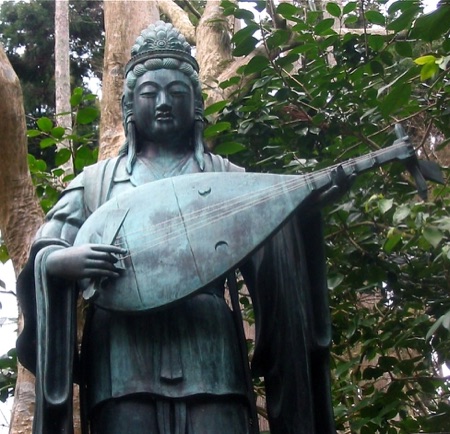
Biwa History
The biwa arrived in Japan from China and Korea approximately 1300 years ago, with what is still Japan’s orchestra of the court, Gagaku. There is also evidence that other biwa instruments came from the Indian lute tradition. In the 9th century the Mõsõ (blind monks') biwa began to be used by blind musicians as an accompaniment to chanted religious texts and sutras. At the beginning of the 13th century, Heike biwa players began telling of tales of the rise and fall of the Taira clan in 12thC Japan.
Biwa Performance
The Biwa performance style has been refined over the years so that it can create scenes and enhance imagery in such a manner as to bring stories to dramatic life before the audience. It has a uniquely expressive sound with the potential to create drama by powerfully plucked sets of notes interspersed with quieter passages. Often, performance traditions use biwa music as interludes inserted between passages of sung narration.
Biwa Construction
The traditional instrument (about three feet long) has a body commonly made of a solid piece of hollowed-out mulberry (or rosewood, quince) and a paulownia wood soundboard, with silk strings stretched over fixed wooden and bamboo frets. The expressive sound gains character from the sawari effect, a buzzing percussive sound that originates from the top end of the fretboard at the 'nut', where strings resonate against a shaped piece of bamboo. The bachi (plectrum), strikes the strings in a sweeping motion whilst the other hand varies the string tension over the frets to produce a wide variety of pitches.
The Shamisen
The shamisen (also called the sangen), a three-string lute with a fret-less fingerboard (about 38 inches long in Jiuta style), is one of the main instruments used in many Japanese musical traditions. Its construction is elegant and refined, consisting of a long narrow wooden neck, a resonating wooden box covered both sides with animal skin, and a set of woven silk strings stretched over a water buffalo horn, tortoiseshell or wooden bridge.
The sound, percussive in nature, is produced by plucking strings with the sharp edge of a large plectrum made of ivory, tortoiseshell or wood, called a bachi. The 'thwacking' sound quality forms the backbone of ensemble compositions, providing a foil for the other instruments to weave their melodies around.
The shamisen is believed to have been imported into Japan from the Ryûkyû Islands in the mid-16th. century. It found its way into many genres of music including folk and popular music as well as the art music of the Edo period (1603-1868). During this period, music for the jiuta shamisen evolved into ensemble music with koto and shakuhachi (Sankyoku). The shamisen is found in almost every genre of Japanese performance, from Kabuki and sankyoku to storytelling, Bunraku puppet theater, Nihonbuyo dance and the many folk music genres.
Jiuta Shamisen music
Yoko Hiraoka was trained from an early age in the Jiuta genre of shamisen music. This is a form of accompanied sung poem with long drawn-out syllables. The songs are often structured in a jo ha kyu form...a slow beginning with sung poem (maeuta) rising to a fast expressive instrumental-only passage (tegoto), finally finishing with, again, a slower passage with a sung poem (atouta). The many variations on this structure provide endless fascination and musical enjoyment.
The poems reflect Edo period engagement with themes of nature (particular villages, mountains, or even a particular tree. Themes of the seasons, seasonal nature activities and so on). Love in all its colours was also a popular subject. Often the love stories are somewhat tragic, usually involving a lady who has been abandoned by her lover, or who is in an impossible amorous situation. These love themes tie in with the another area of expression: the evanescence of life. Buddhist notions of suffering, loss and the ever-changing aspects of being alive are woven into poetic stories. The percussive sounds of the plucked shamisen strings are a perfect foil to the deeply-felt poems